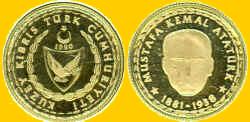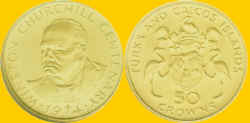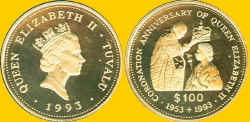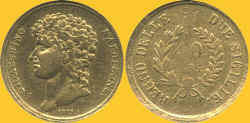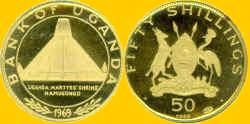This is the Worldwide Numismatics Website!
This is a modest collection of second millennium gold coins
Click the thumbnail picture to see a larger version of the picture, then use your browser BACK button to return to the original page you were viewing.
TURKISH REPUBLIC OF NORTH CYPRUS
1 Sovereign - 1990
KM-??? - 6,600 g
Mintage - 774
This NCLT "coin" was issued to celebrate the 7th anniversary of independence. The obverse has the region's crest with the legend KUZEY KIBRIS TURK CUMHURIYETI (Turkish Republic of North Cyprus) and the date 1990 above the center of the crest. The reverse features the facing image of Ataturk, founder of modern Turkey. His name MUSTAFA KEMAL ATATURK and his birth and death years 1881-1938 encircles the bust.
TURKS & CAICOS ISLANDS
Local legend has it the Christopher Columbus made his first Western Hemisphere landfall in 1492 on Grand Turk Island. The local populace the Tainos were extinct by the mud-1500s. The islands were claimed at various times by Britain, France, and Spain with Britain finally prevailing. The islands were uninhabited until 1678 when a group from Bermuda arrived where they established a salt processing industry. The islands became a haven for pirates in the Caribbean. They joined with Jamaica until that island was granted independence in 1962. In 1973, the islands became a Crown Colony.
50 Crowns - 1974
KM-003 - 9,000 g
Mintage - 0,030
This NCLT "coin" was issued to honour Sir Winston Churchill, the World War II leader of Britain. The obverse has a bust of Churchill with the legend WINSTON CHURCHILL CENTENARY and the date 1974. The reverse has the colony's arms with the colony's name TURKS AND CAICOS ISLANDS at the top and the denomination 50 CROWNS at the bottom.
TUVALU
Spanish mariner Don Alvaro de Mendaņa y Neyra passed through the coral atolls of Tuvalu in 1597. Europeans visited the islands in the late1700s and mapped themby 1826. They were named the Ellice Islands after the British MP who owned the ship that first landed on Funafuti Atoll in 1819. In 1892 the islands became part of the Gilbert and Ellice Islands protectorate, then, in 1916, a crown colony. During WWII the USA used Tuvalu's northernmost atoll, Nanumea, as a base to repel the Japanese who were threatening the Gilbert Islands. From the 1960s through to 1977, Tuvaluans embarked on steady constitutional development. In 1974 the Ellice Islanders voted to separate from the Micronesian Gilbertese. They then reverted to their pre-colonial name of Tuvalu ('eight standing together') and attained independence on 1 October 1978.
$100 - 1993
KM-129 - 7,776 g - 25 mm
Edge - Reeded
This NCLT "coin" was issued to commemorate the 40th anniversary of the Coronation of Elizabeth II. The obverse features the Machin bust of Elizabeth II. Her title QUEEN ELIZABETH II, the country's name TUVALU, and the date 1883 encircle the bust. The reverse has the Archbishop placing the crown of Elizabeth. The denomination $100 is below the scene. The legend CORONATION ANNIVERSARY OF QUEEN ELIZABETH II 1953-1993 encircle the tableaux.
KINGDOM OF TWO SICILIES
In 1806, the French invaded southern Italy, and the Bourbons who were the rulers fled to Sicily. Napoleon once again reshaped the political landscape of Italy; he installed his brother Joseph as the King of Naples (his Kingdom, as compared to that of the Bourbon kings, reduced to the mainland stretches of the kingdom). In 1808, Joseph was made King of Spain, and the Kingdom of Naples passed to Napoleon's brother-in-law, Joachim Murat, the most ambitious and energetic among the kings Napoleon installed. Under his rule a number of reforms were passed, which did not survive his reign. The Kingdom was known under two names, the Kingdom of Naples and the Kingdom of Two Sicilies (one being the island of that name, the other mainland south Italy). Joseph and Murat used the latter title, which expressed their claim on the island of Sicily. During the Wars of Liberation, Austrian troops entered Italy to end French influence on the peninsula. Murat, deserting Napoleon's cause after the Battle of Leipzig, remained in power and in 1814 the Vienna Congress was willing to accept him as ruler. However, during Napoleon's 100 days in 1815, Murat rejoined the French side, aspiring to become King of Italy. The Battle of Tolentino in 1815 saw the Austrians victorious and Murat's reign end. The Bourbon dynasty was reinstated once again. Murat, who had fled to Corsica, tried to retake Naples once again and was killed during the attempt.
40 Lire - 1813
C-113 - 12,9 g
Mintage - 0,024M
This coin was minted The obverse features a bust of Joachim Murat (b1767-d1815), husband of Caroline Bonaparte, sister of Napoleon. The Italian legend around the bust reads GIOACCHINO NAPOLEONE with the date 1813 below the bust. The reverse has the denomination 40 LIRE within a wreath encircled by the country's name in Italian REGNO DELLE DUE SICILIE.
UGANDA
Uganda is a land-locked country in East Africa. It was settled by Bantu and Nilotic tribes. The United Kingdom placed the area under the charter of the British East Africa Company in 1888, and ruled it as a protectorate from 1894. As several other territories and chiefdoms were integrated, the final protectorate called Uganda took shape in 1914. Uganda became an independent nation in 1962, with Edward Muteesa II, the Kabaka (King) of Buganda as the President with Milton Obote as Prime Minister. In 1966, Obote overthrew the constitution and declared himself president, ushering in an era of coups and counter-coups which would last until the mid-1980s. Obote was deposed twice from office, both times by military coup. The most infamous of Ugandan leaders must be Idi Amin who in time was deposed as well.
50 Shillings - 1969
KM-014 - 6,91 g
Mintage - 0,004M
This NCLT "coin" was issued to commemorate the Papal Visit of Paul VI to Uganda where he canonized the Martyrs of Uganda whicjh was a group of 45 Christians, both Catholics and Protestants, killed by Mwanga II, ruler of Buganda between 1885 and 1887. The obverse features the Martyr's Shrine at Namugongo encircled by BANK OF UGANDA and the date 1969. The reverse has the national arms encircled bu the denomination FIFTY SHILLINGS 60.
If you would like to see additional gold coins, please click here - Page 34
If you want to return to the home page, please click here - Home
